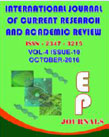Abstract Volume:4 Issue-10 Year-2016 Original Research Articles
 |
Online ISSN : 2347 - 3215 Issues : 12 per year Publisher : Excellent Publishers Email : editorijcret@gmail.com |
Enterocutanaeous fistula mean connection between stomach, small or large bowel and skin with loss of gut content, about 75 - 90% are postoperative following any laparotomy especially of trauma and previous laparotomy of other procedures, may be classified depending on etiological, physiological and anatomical factors, on this classification the management of ECFs closure rate depend. The morbidity and mortality related to fluid and electrolytes losses, sepsis and malnutrition. So treatment include after diagnosis to correct fluid and electrolytes deficit with other elements by controlling fistula output by a lot of things, prevention and treatment of malnutrition by oral diet, enteral or parenteral nutrition accordingly with control of sepsis and great care and strict follow up of patients that mean conservatively, if closure of fistula not occurred after 4 - 6 weeks, so prepare for surgical closure after improvement of general condition and nutrition of patients. To assess the outcome of using high negative pressure vacuum with foley cather and some modified normal oral diet in closure of postoperative enterocutaneous fistulas. Between a period from 2012 to 2016 in a medical city of AL-sadder teaching hospital in AL-Najaf, Iraq, treated prospectively with recently developing postoperative enterocutaneous fistulas using vacuum method with Foley catheter to close the fistula tract and change the contents daily for 14-21 days as necessary after exclusion of intra-abdominal infection, distal bowel obstruction, abdominal malignancy, abdominal irradiation and inflammatory bowel disease by abdominal imaging, all patients allowed to eat some modified normal diet with some simple drugs and IV fluid and even with home care program accordingly. A 51 patients with age 45 ± 22 years were 40 men and 11 women, all of them developed postoperatively were treated by vacuum method, the moderate and low output fistulas had the best results of 34 cases (94.4%) were closed and 13 cases (86.6 %) of high output were closed at the end of study. 35 (68.6%) cases closed after 7 days, 10 cases (10.6%) after 14 days and 2 cases (3.9%) after 21 days of this vacuum method of a successful vacuum closure rate of 47. Treatment failed in remaining 4 cases (7.8%), 2 patients of low and moderate and 2 of high outputs were subsequently did for them surgery. The prognostic factors were used are serum albumin and hemoglobin levels were showed significantly higher levels at the end of than at the beginning of this study. No patient died. The vacuum method showed best results in spontaneous fistula closure with it's simplicity, low cost, short hospital stay even at home, no skin breakdown, on normal oral diet with some modification, some simple drugs and fluid with good nutrition and usual daily activity.
How to cite this article:
Hassan H. Zaini. 2016. The Outcome of Treatment of Postoperative Enterocutaneous Fistula using High Negative Pressure Vacuum and Some Modified Normal Oral Diet: A Review of 51 Cases Over a 4 - Year Period, Iraq. Int.J.Curr.Res.Aca.Rev. 4(10): 155-165doi: http://dx.doi.org/10.20546/ijcrar.2016.410.018



Quick Navigation
- Print Article
- Full Text PDF
- How to Cite this Article
- on Google
- on Google Scholor
- Citation Alert By Google Scholar
